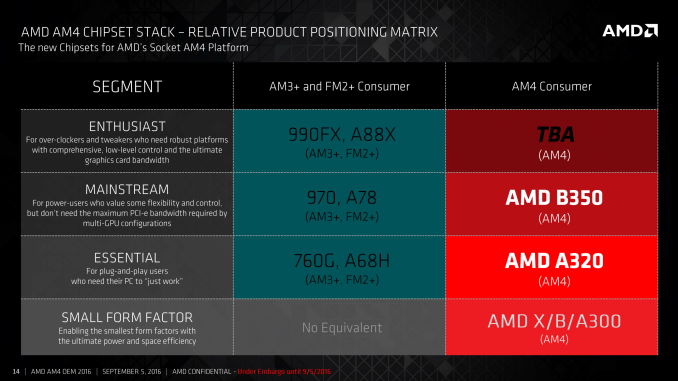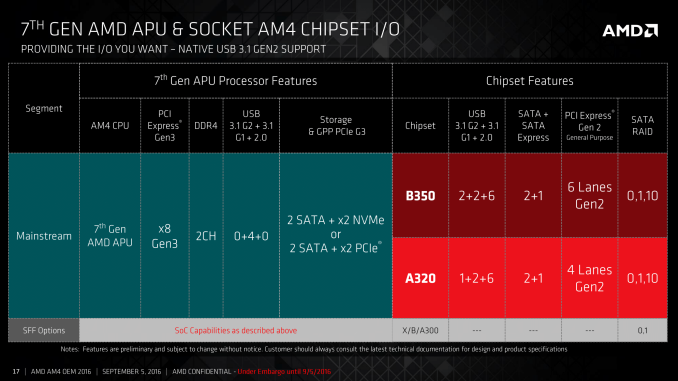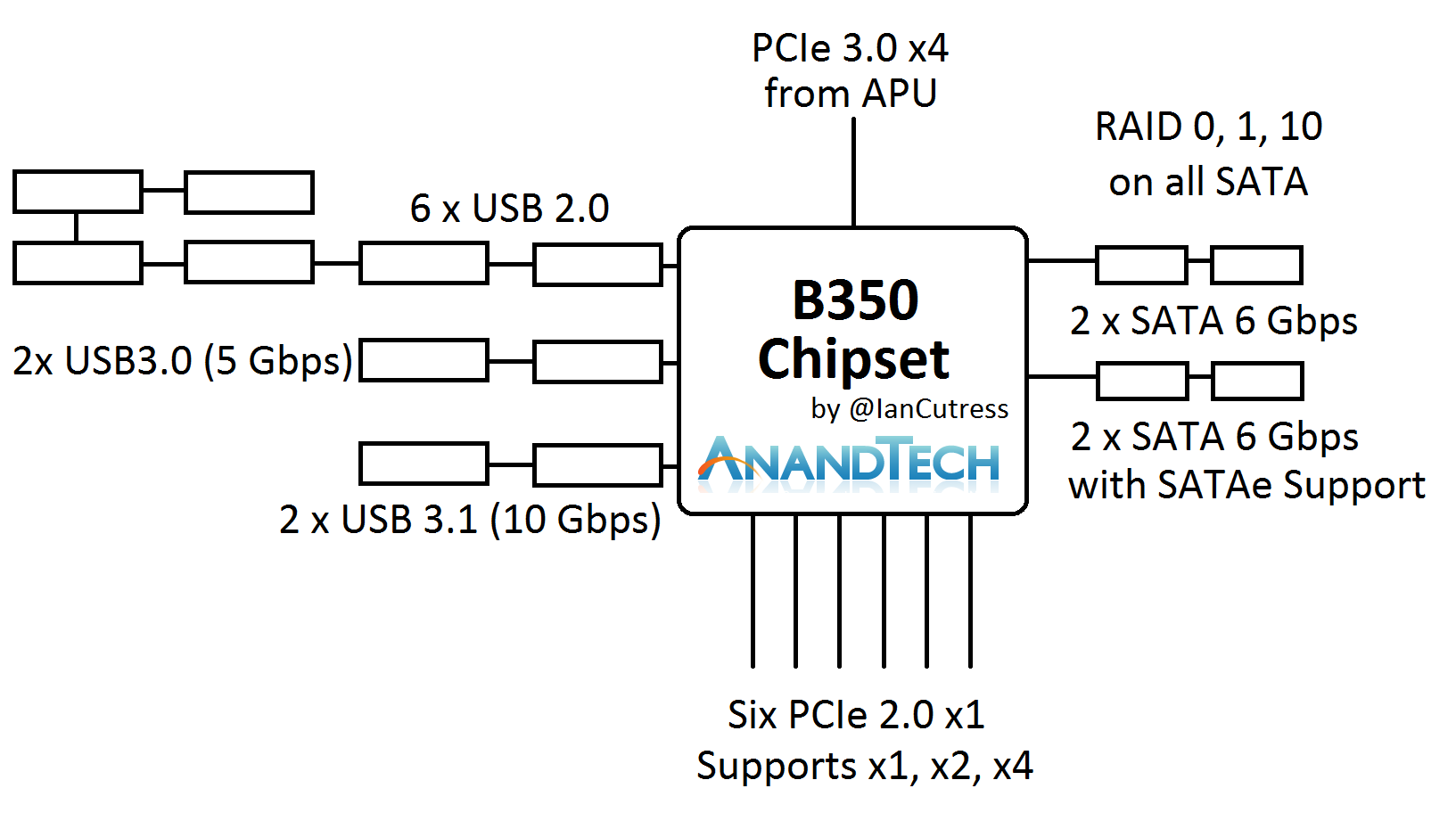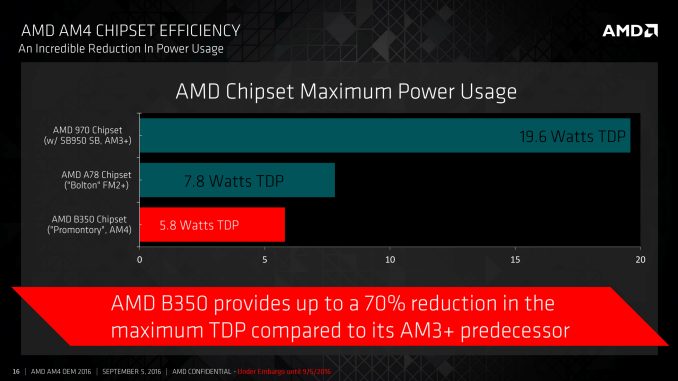AMD 7th Gen Bristol Ridge and AM4 Analysis: Up to A12-9800, B350/A320 Chipset, OEMs first, PIBs Later
by Ian Cutress on September 23, 2016 9:00 AM ESTThe Two Main Chipsets: B350 and A320
Despite all the crazy potential that might come from playing with PCIe, if a user wants more than a couple of SATA ports or x1 slots, the chipset is there to provide. For the Bristol Ridge OEM launch, there are two main chipsets with a further three aimed more at embedded platforms. We’ll focus more on the first two.
It’s worth noting that AMD has specifically listed that the B350 chipset is not the premium chipset for AM4. We know that Zen will be a part of the AM4 socket and ecosystem, and it would seem that there is at least one specific chipset for the high-end desktop market set to come later. Feel free to speculate.
The B350 and A320 chipsets are mostly identical, using the PCIe 3.0 x4 from the CPU and offering a variety of SATA, USB and PCIe 2.0 connectivity. The PCIe 2.0 lanes, six on the B350 chipset and four on the A320 chipset, support x1, x2 and x4 modes for an array of different controllers. Perhaps the interesting thing here is the support of USB 3.1 at 10 Gbps, which is provided as native support from the chipset.
The main provider of USB 3.1 controllers in the market currently, ASMedia, has been floated around as a partner with AMD in designing these chipsets. We asked AMD if ASMedia was involved, and to what extent, in the development or IP of the hardware. We were told that while the IP is with AMD, ASMedia were bought on as a partner in some fashion (most likely as a design firm or a consultant) to help produce the hardware. We were informed that the chipsets are manufactured at TSMC using a 55nm process, which is a much cheaper process than 28nm or 16nm.
An additional aside, the chipset USB 3.1 ports do not support reversible Type-C natively. We have been informed that a re-driver chip is required to support the revisable connectivity, which is a minor additional IC required by the OEMs.
Aside from the native USB 3.1 output, AMD’s chipset offerings are far behind Intel’s current implementation, affording up to 20 PCIe 3.0 lanes from their chipset despite the same uplink equivalent. This is partly because Intel’s chipset has steadily grown and looks more like a PCIe switch itself. AMD is claiming that the external B350 chipset, compared to the older AM3 platforms, comes down from 19.6W TDP to 5.8W TDP.















122 Comments
View All Comments
jardows2 - Friday, September 23, 2016 - link
Really looking forward to some actual benchmarks. I really am itching to build a new office computer, and right now, the i3-6100 is the only realistic chip, since I won't be doing much gaming on the system. If the new A12 and A10 can even come close to matching the i3 in CPU tasks, I'd be more than happy to snag that up, as the graphics will be nice, and the upgradability to Zen later if that processor pans out.Danvelopment - Saturday, September 24, 2016 - link
I'm writing an article on that at the moment (different site built around the economics of modern tech). Conclusion is unless you need specific Skylake tech on a desktop (m.2, DDR4, ECC, IGP, SGX, MPX or AVX2), get an Ivy Bridge i5/i7. Ex-lease Ivy machines are pretty much being sold for pennies these days (less than a new Pentium machine) and a quad Ivy i5/i7 will almost always demolish a Skylake i3 on the CPU side.Use the leftover cash for a couple SSDs and beer.
serendip - Saturday, September 24, 2016 - link
And so comes the end of the desktop computer, as people refurbish old computers and use them for years instead of buying new ones every year. That Ivy i5 system paired with lots of cheap RAM and a cheap SATA SSD would be more than fast enough for office tasks for years to come.Could be good for AMD though. They could make good-enough APUs for mainstream usage at a price point Intel can't touch. It's a race to the bottom and AMD could conceivably win.
LordanSS - Saturday, September 24, 2016 - link
Still rocking my 3770k.Skylake wasn't a good enough performance bump for my use cases, considering platform price. Kaby Lake has no IPC boost, and who knows when Cannonlake will arrive.
Waiting on Zen to arrive so I can take a look at benchmarks. Even if it's "slower" than Skylake, if the platform cost is right it would be a quite viable option.
Danvelopment - Sunday, September 25, 2016 - link
Precisely, I just overclocked my 2500K to 4.5GHz the other day and it will definitely last me until Intel gets its act together and puts a focus on performance improvements again.If AMD were competitive, Intel would probably be pushing a lot more performance on successive generations. Instead they're cashing in by shrinking dies and moving more components on die, while only incrementally improving performance.
So really it's a good thing, suddenly competing with the secondhand market will hopefully see a large performance boost in future generations.
patrickjp93 - Tuesday, September 27, 2016 - link
@Danvelopment Please take a look at Agner Fog's x86 instruction latency tables. Intel can't squeeze blood from a rock and make instructions take less than 1 cycle. No one can.patrickjp93 - Tuesday, September 27, 2016 - link
Continuing from the above, that's why SIMD and MIMD instructions were created.Danvelopment - Tuesday, September 27, 2016 - link
So you're saying we've hit the limit for processor performance and there's nothing new anyone can do?I find that hard to believe, especially as innovation is not required to increase performance, hell if they were desperate they could bring i3 to a quad minimum and flop four more cores into 5 and 7 and call it a day. It's not innovation but it's a significant increase in performance potential.
Instead we've gone from a 216mm2 die to a 122mm2 die.
If it were neck and neck, Intel wouldn't look at AMD and go, "whelp, nothing we can do".
Danvelopment - Tuesday, September 27, 2016 - link
216 is Sandy Bridge and 122 is Skylake.jardows2 - Monday, September 26, 2016 - link
Where can I find these "pennies" for Ivy i5? Best I'm finding is on fleaBay for about $200 shipped. With 4GB RAM and too small of a hard drive. After I upgrade the hard drive and RAM to where I need, I have a used computer that costs only about $40 less than if I build a new i3 system. And demolish? I'm not so sure about that:http://www.anandtech.com/bench/product/1783?vs=702
Beat? Yes, but I wouldn't say demolish.